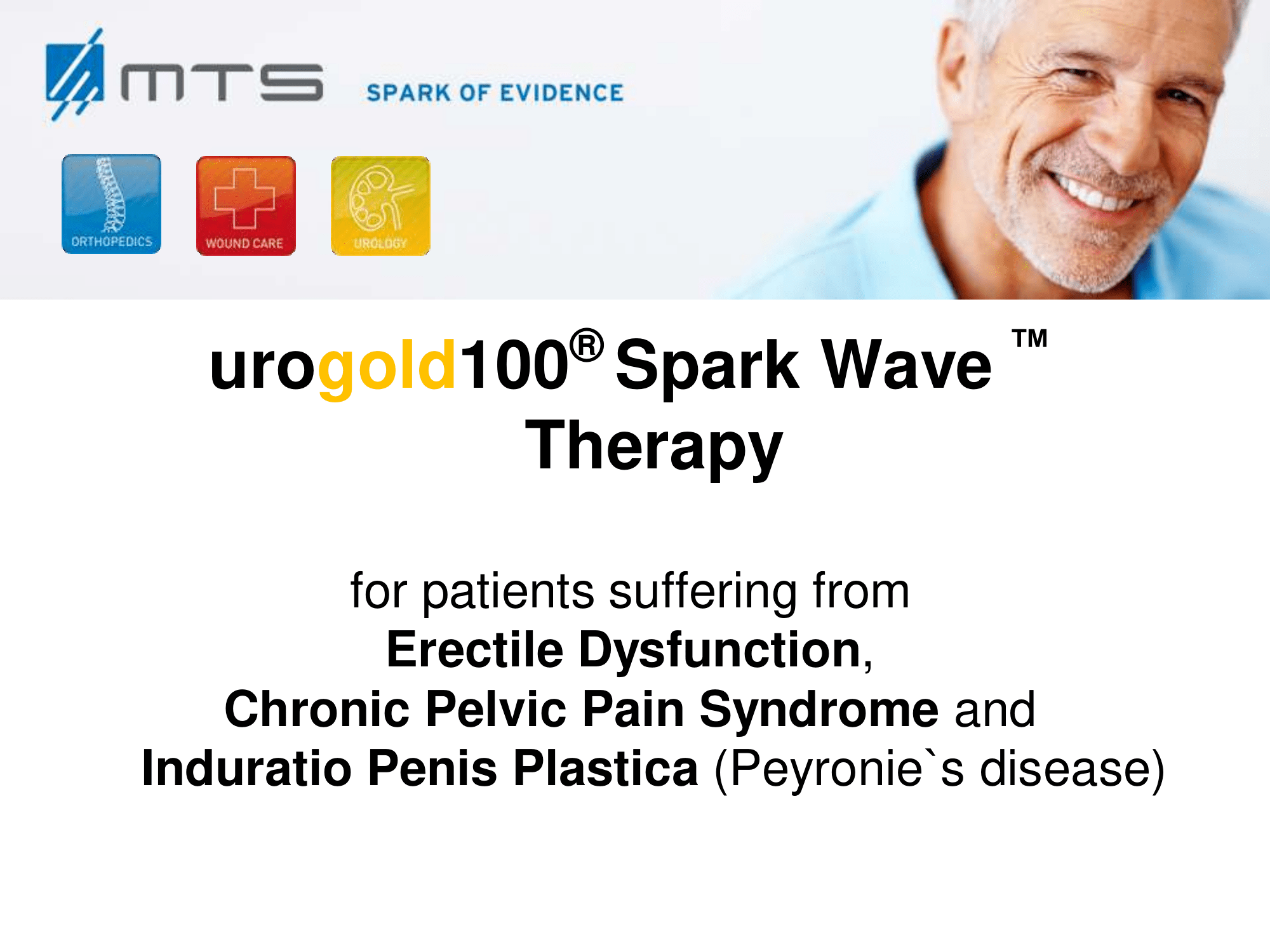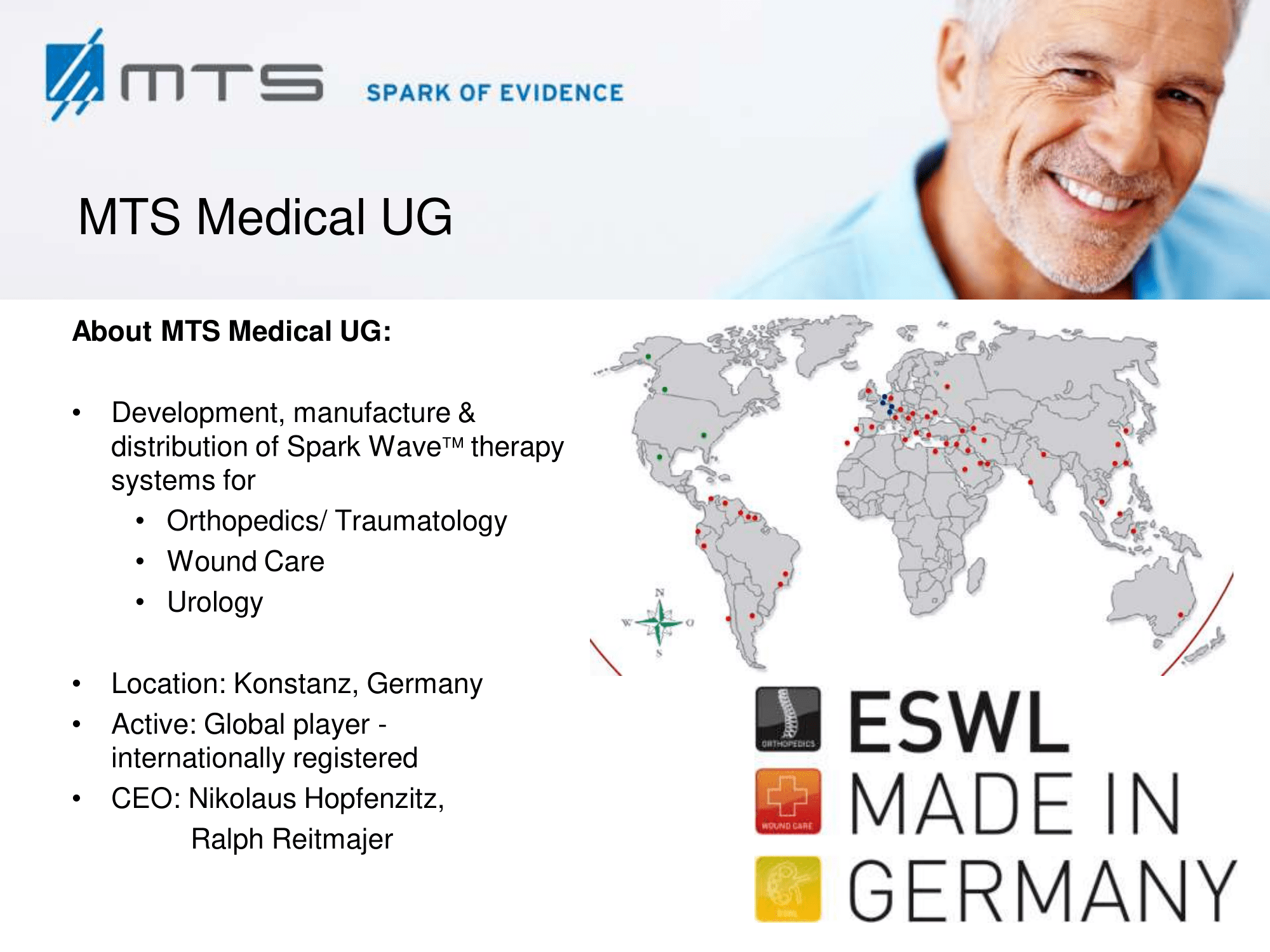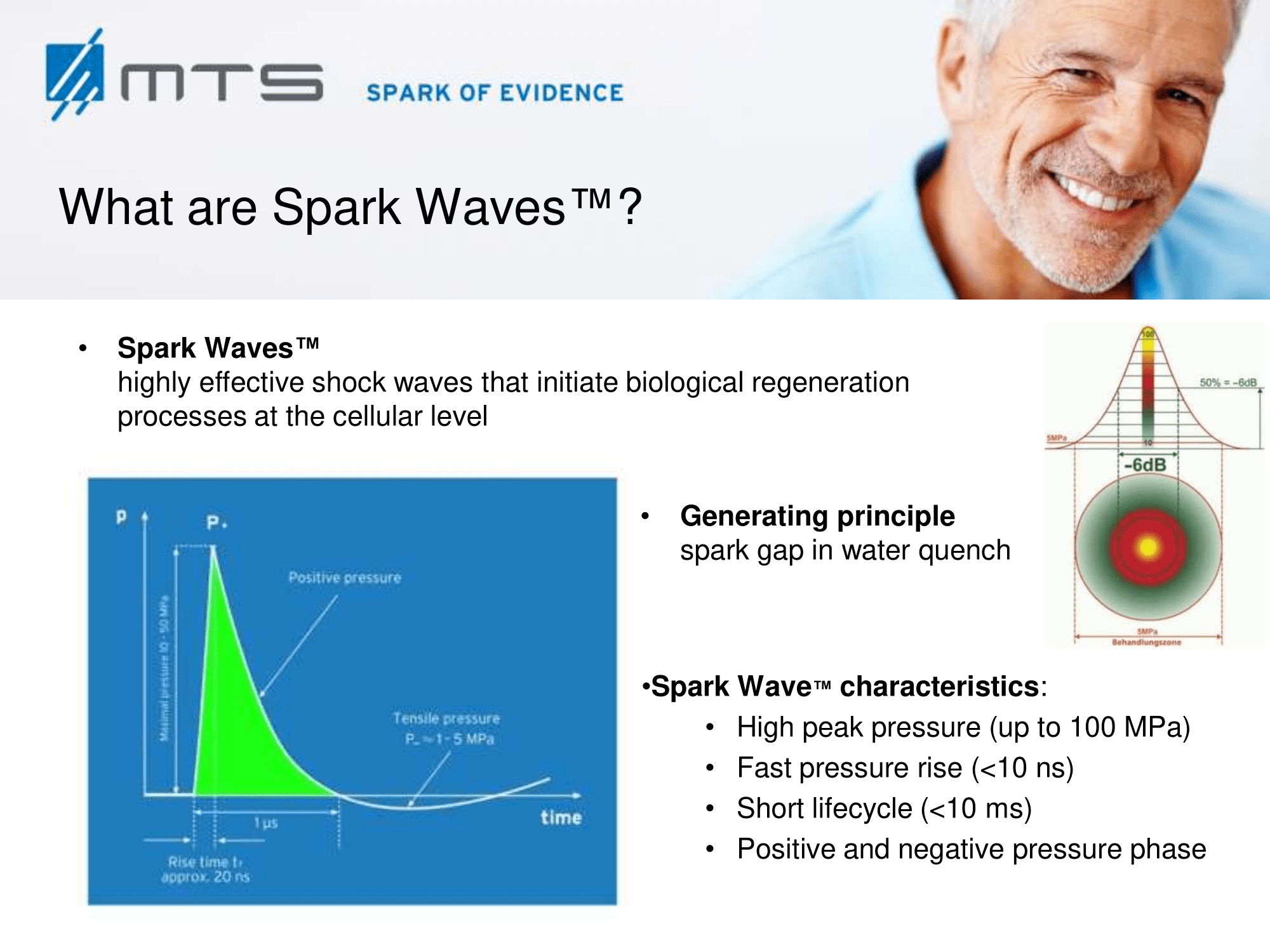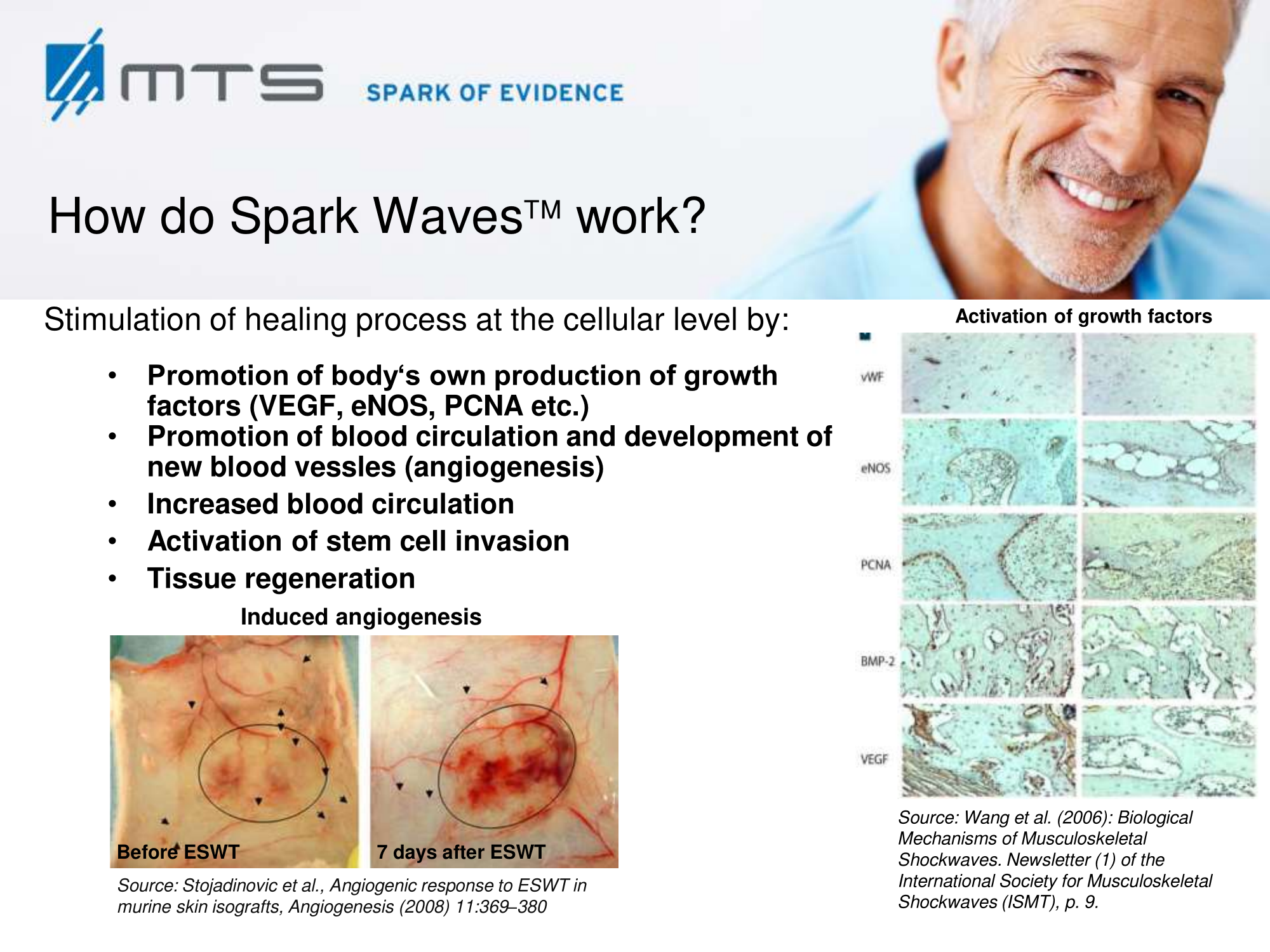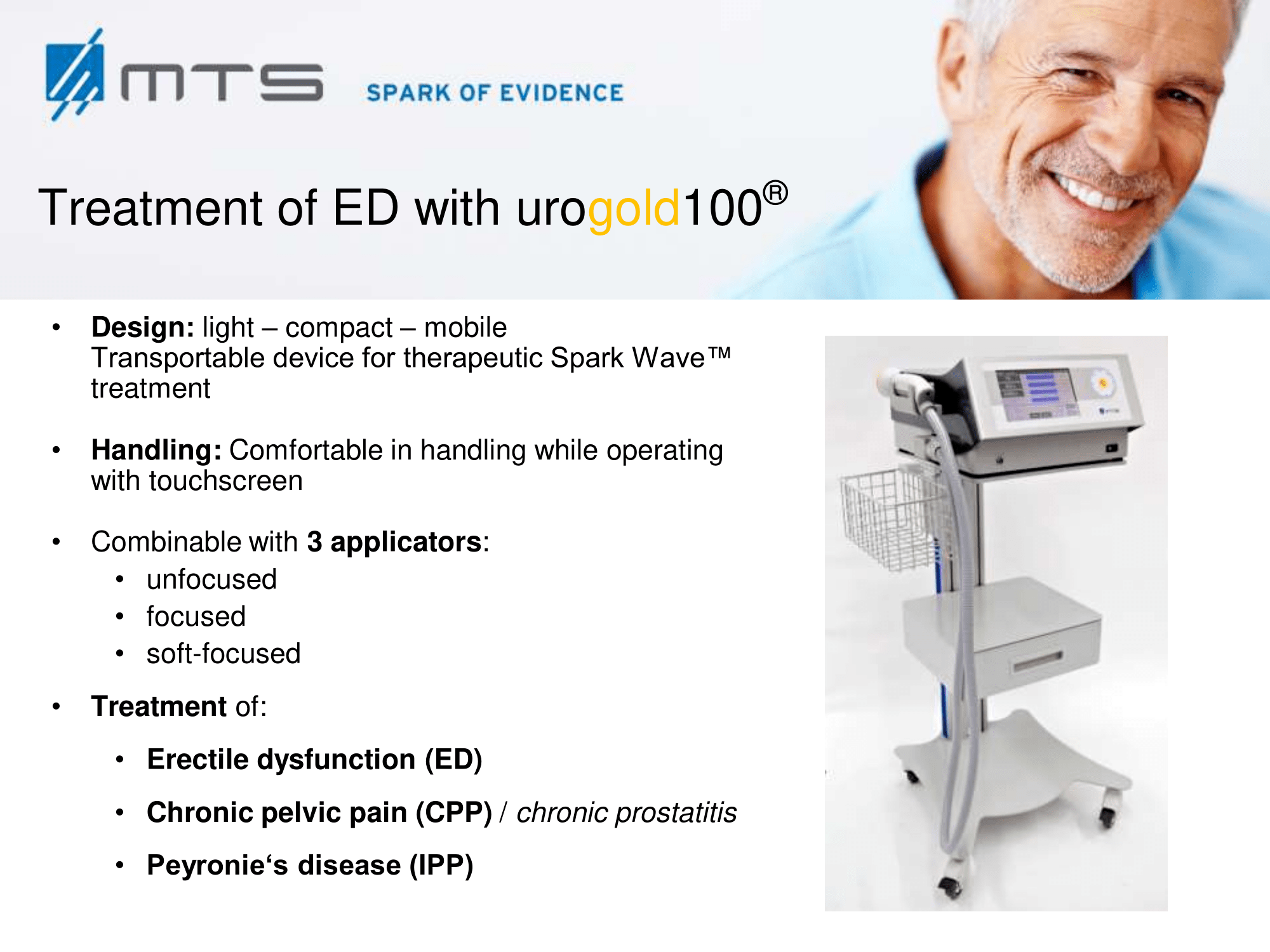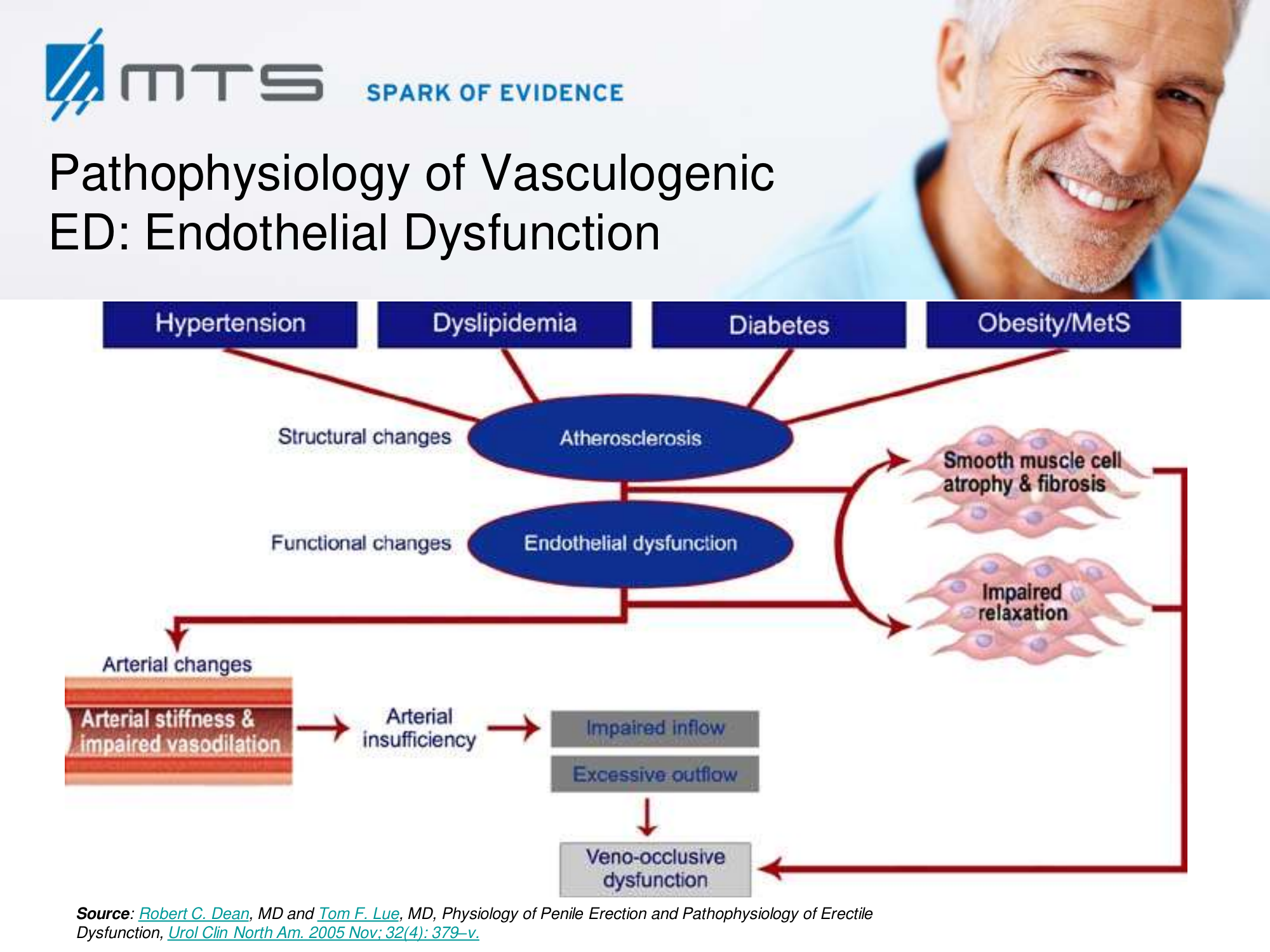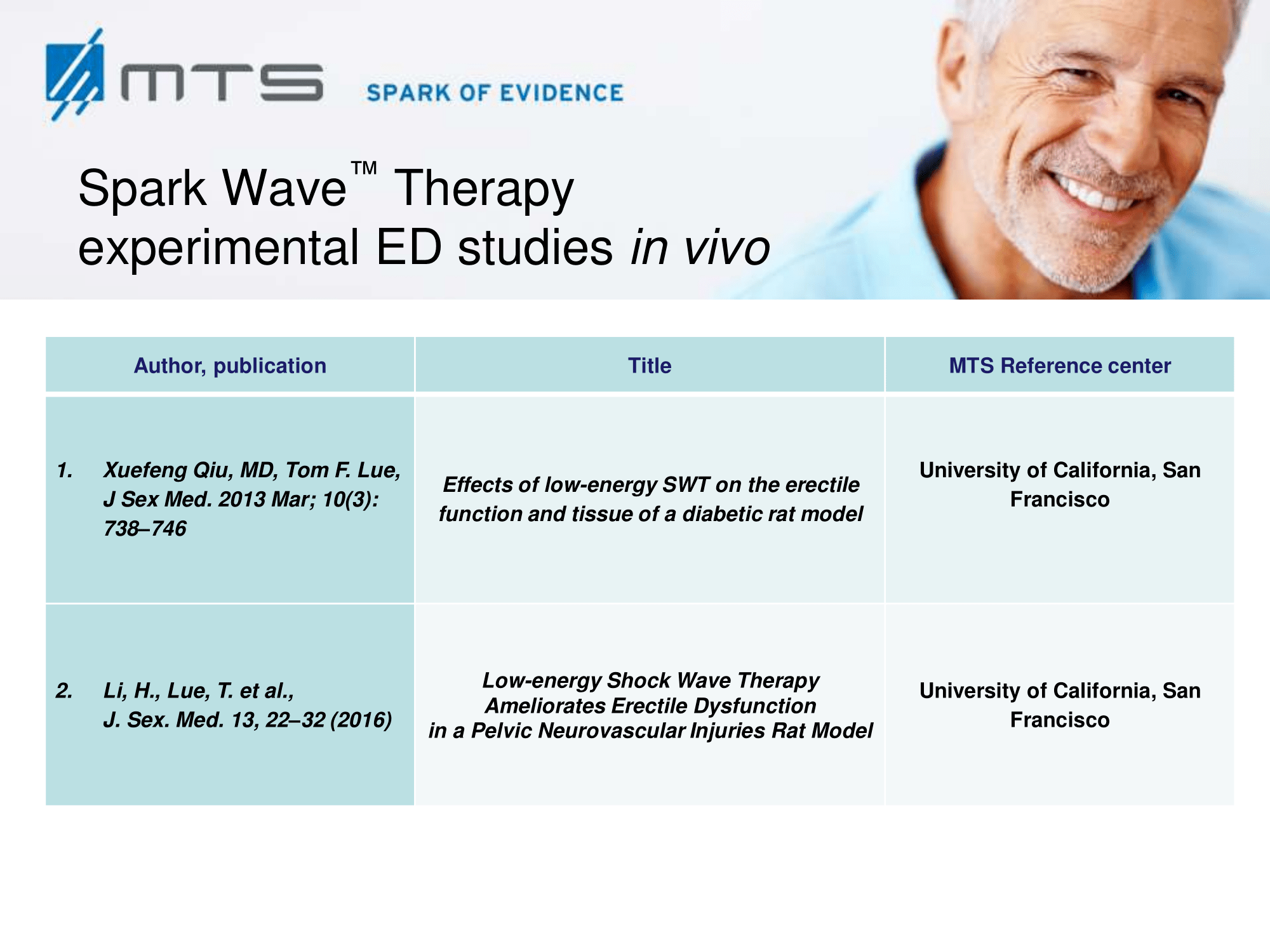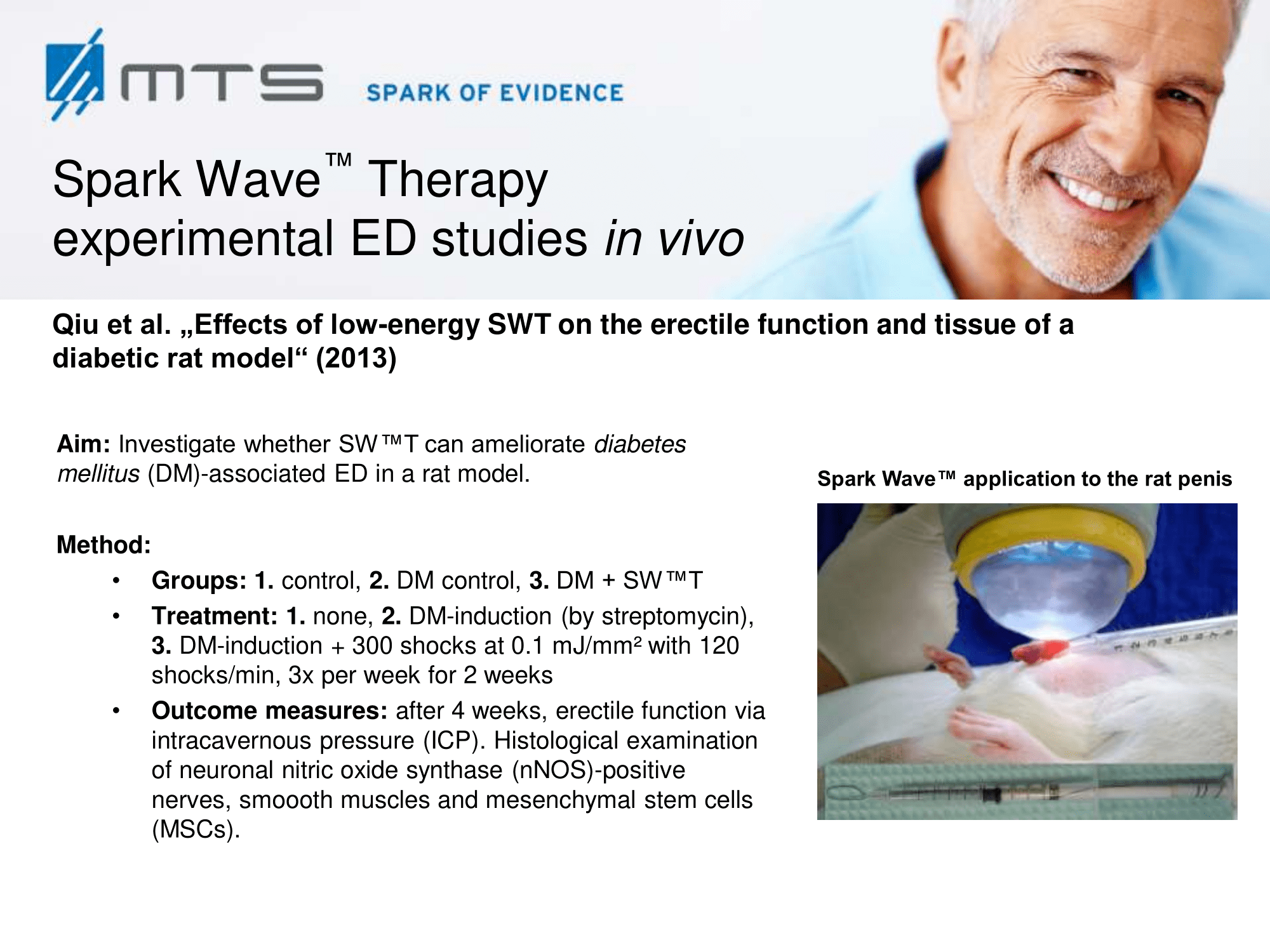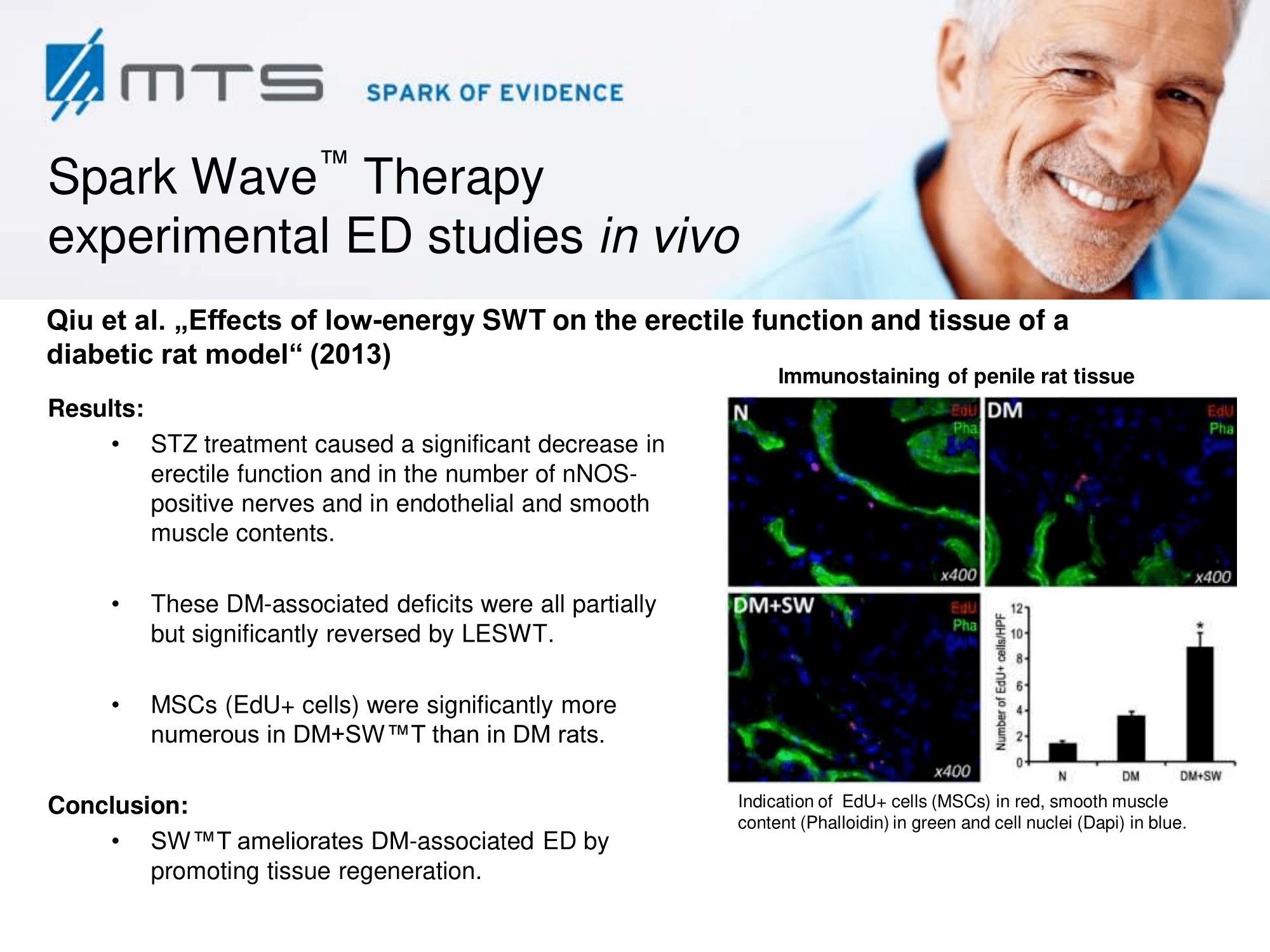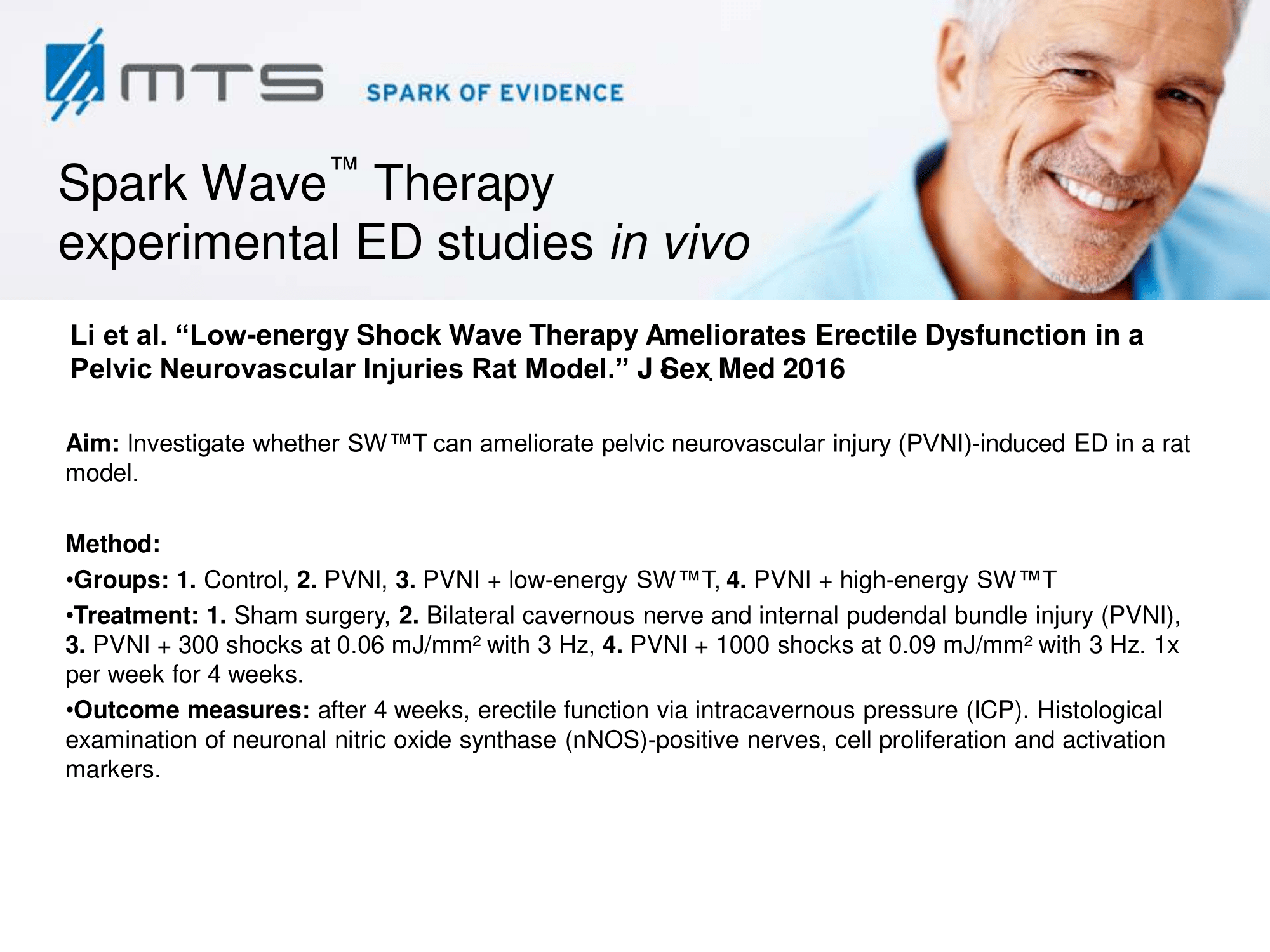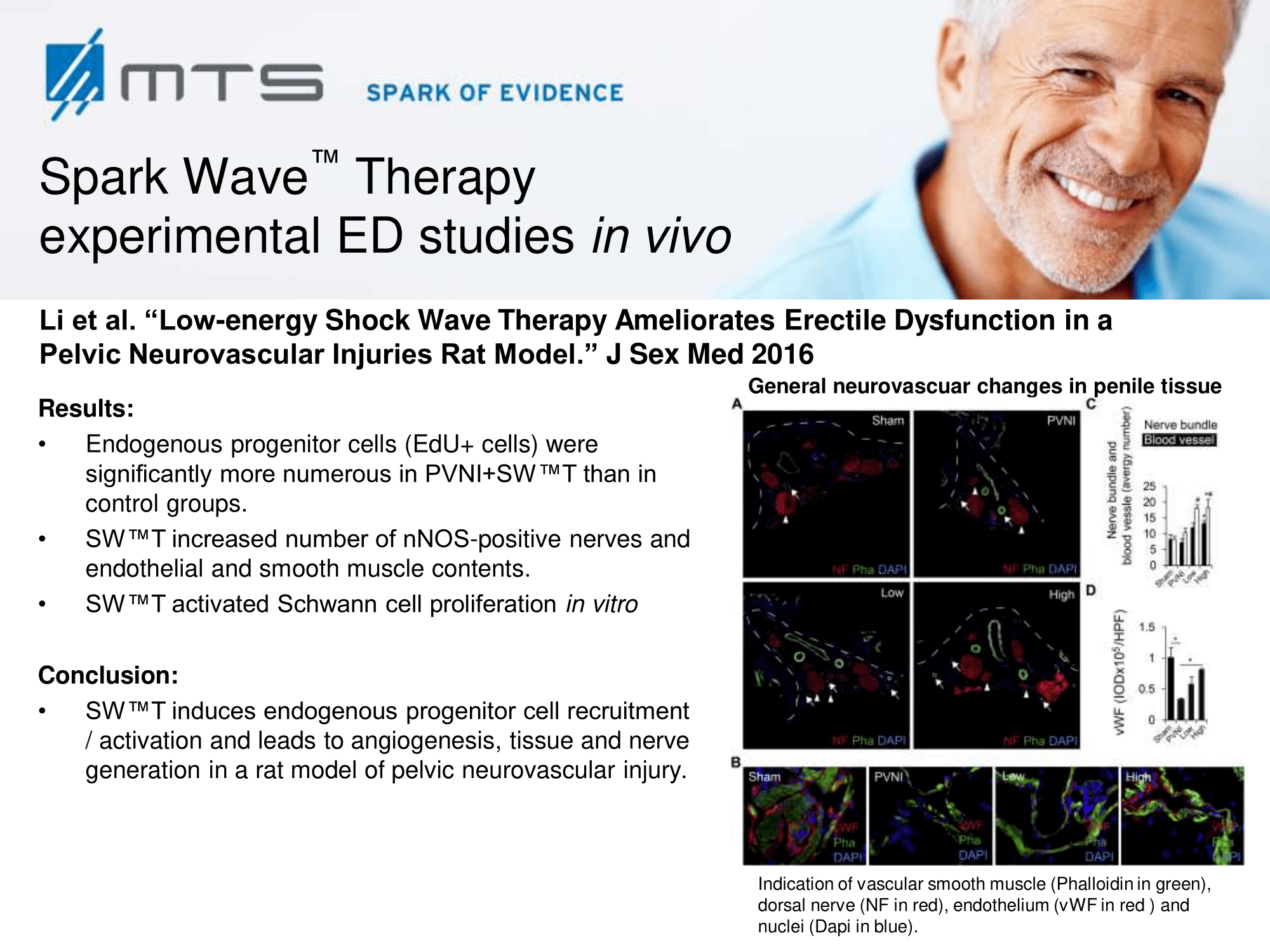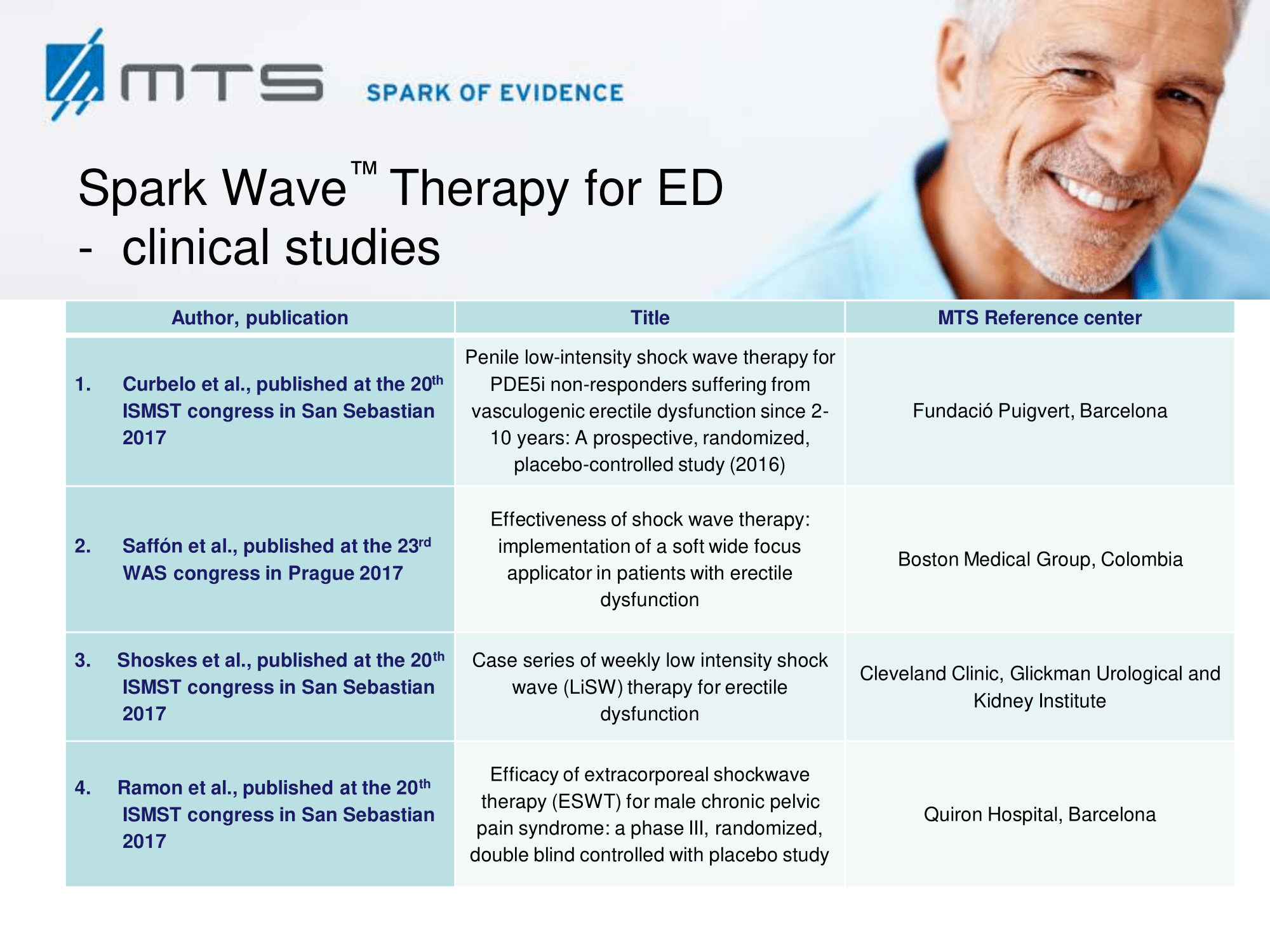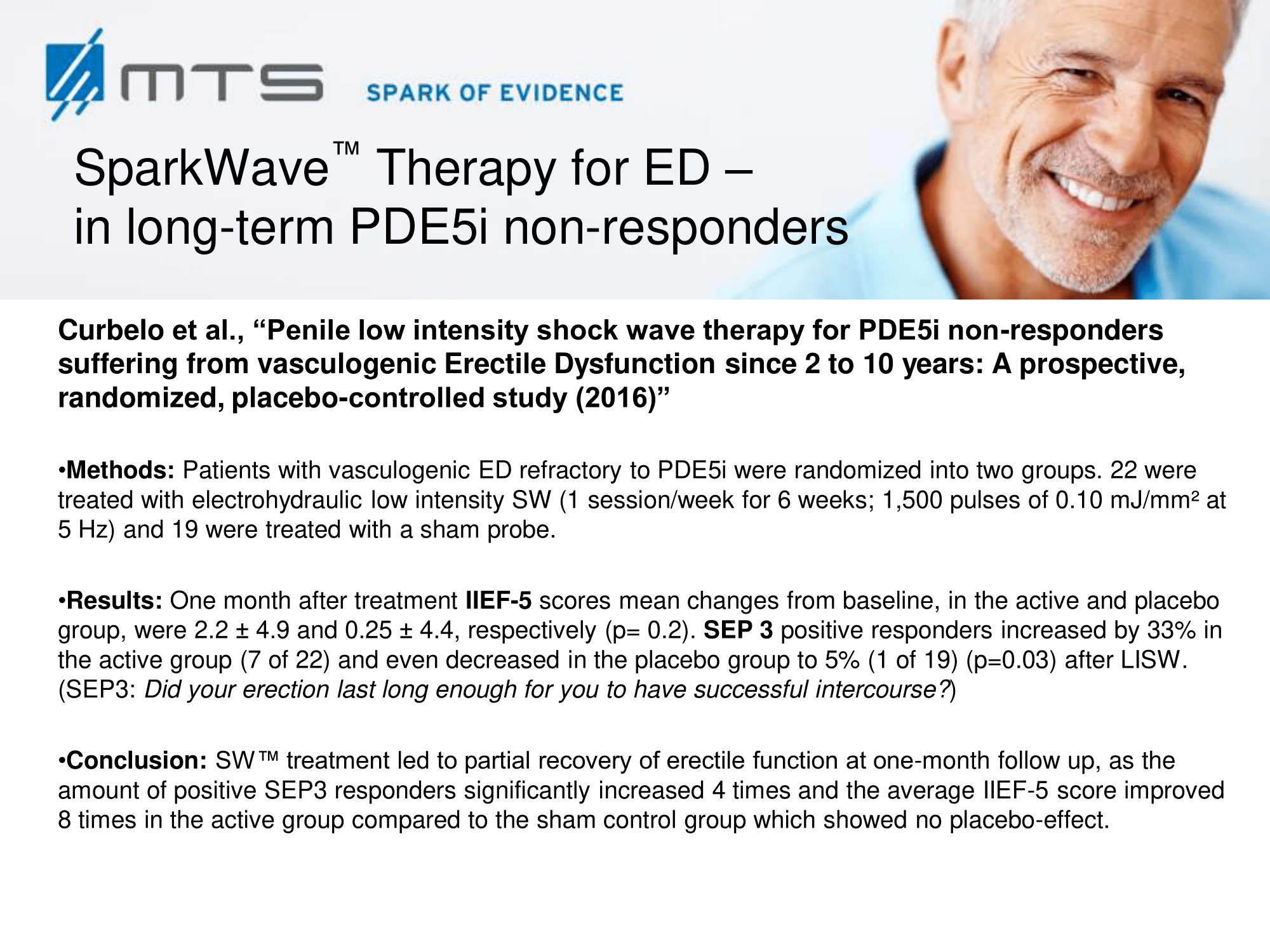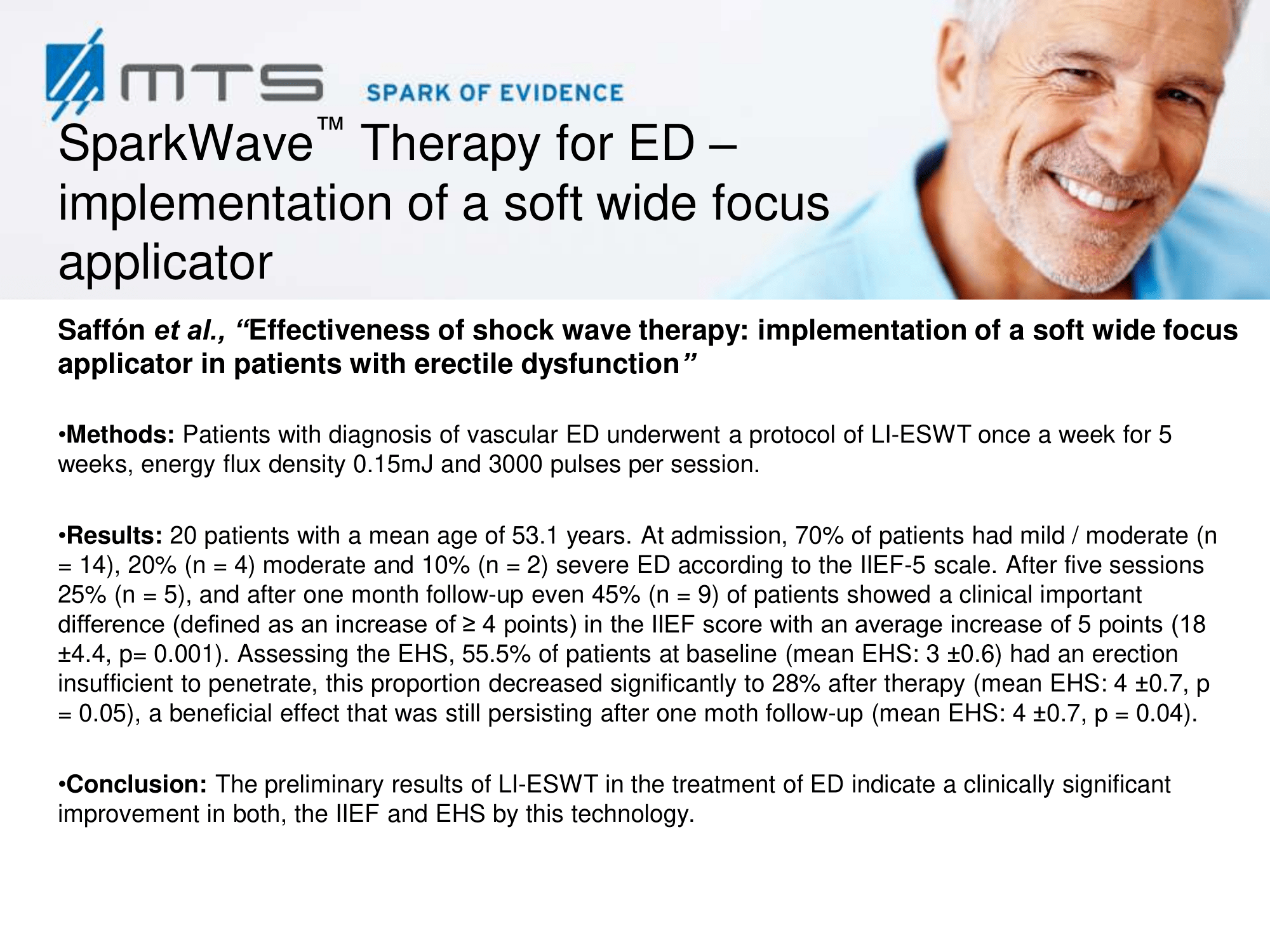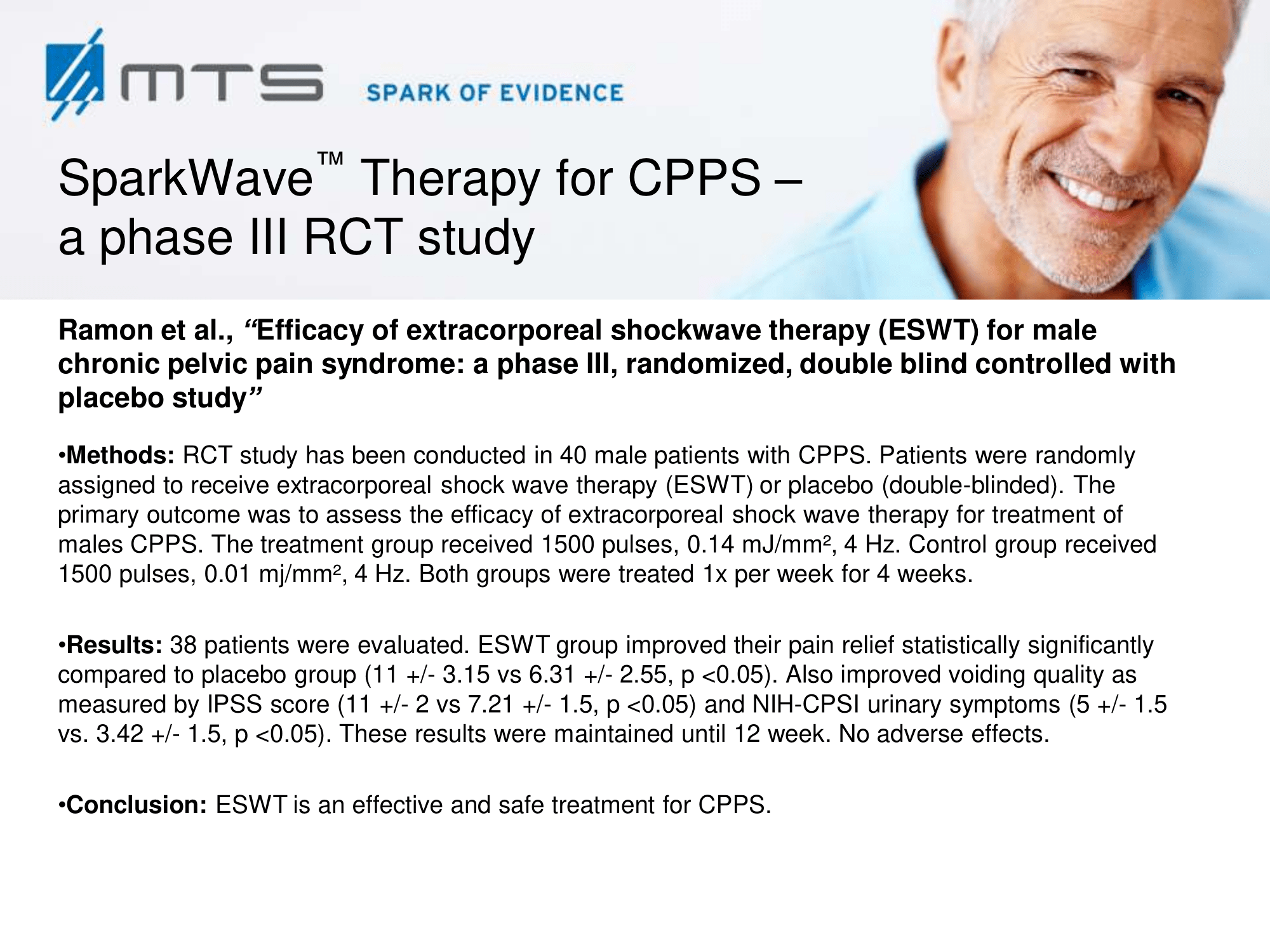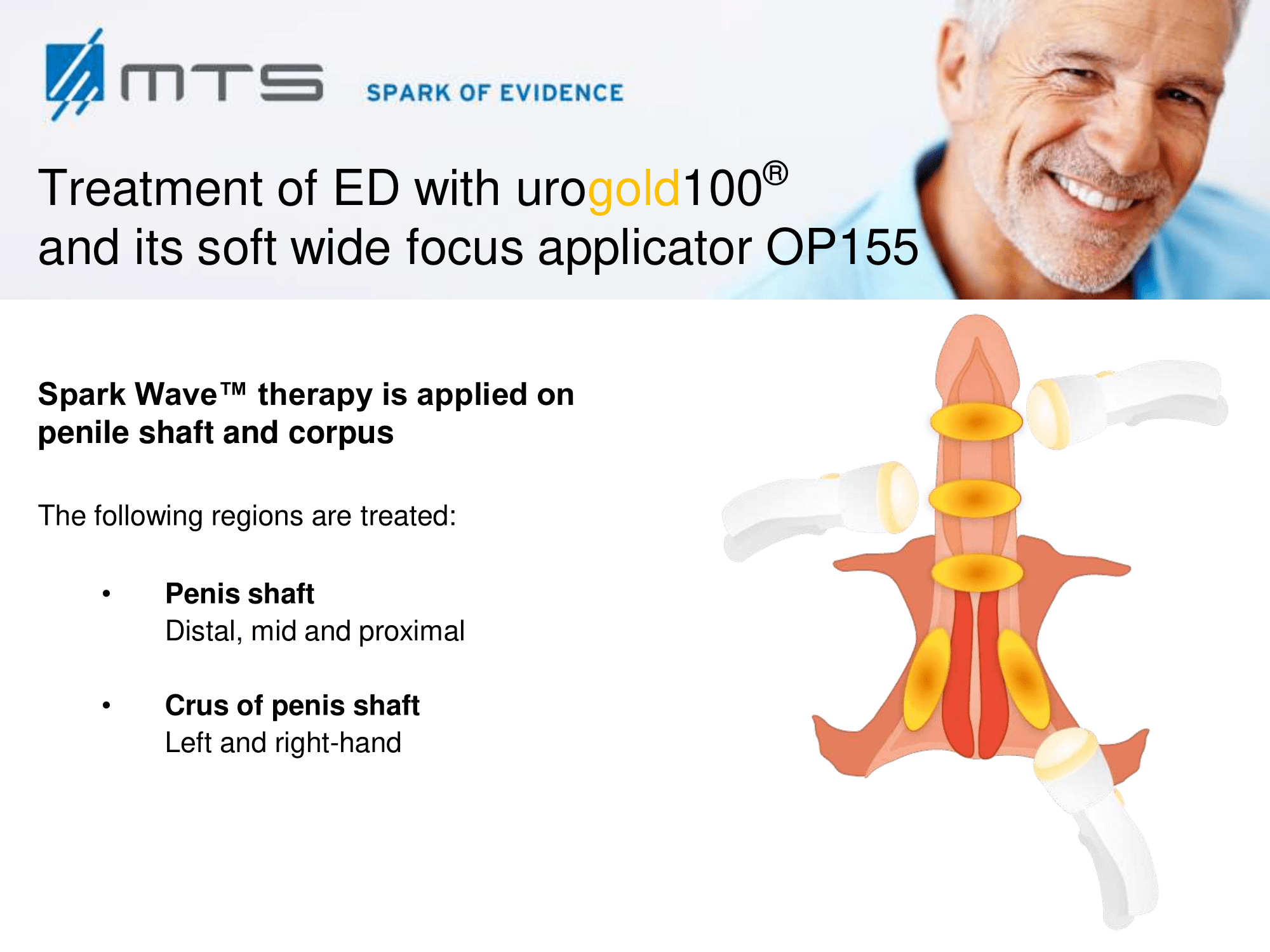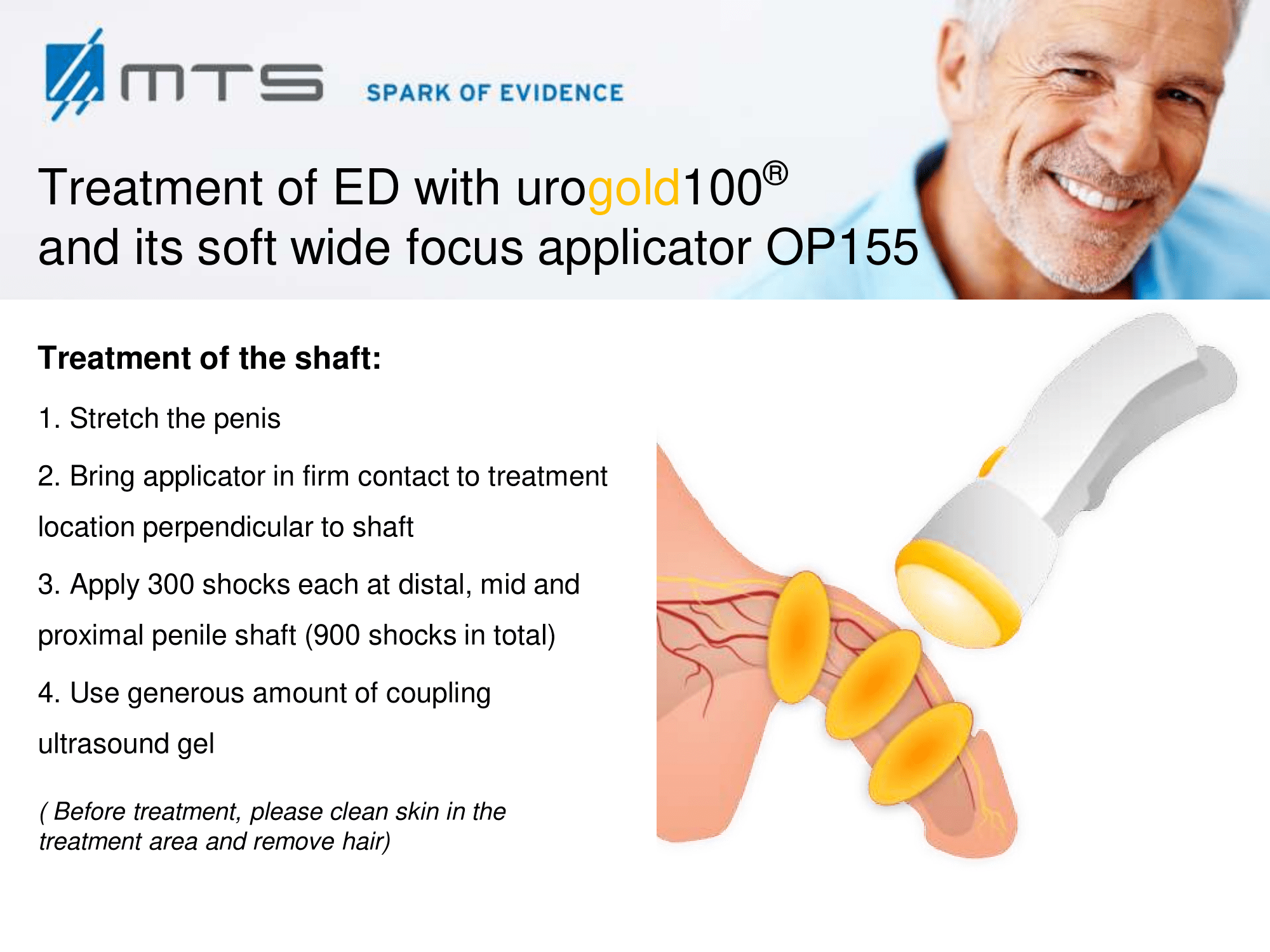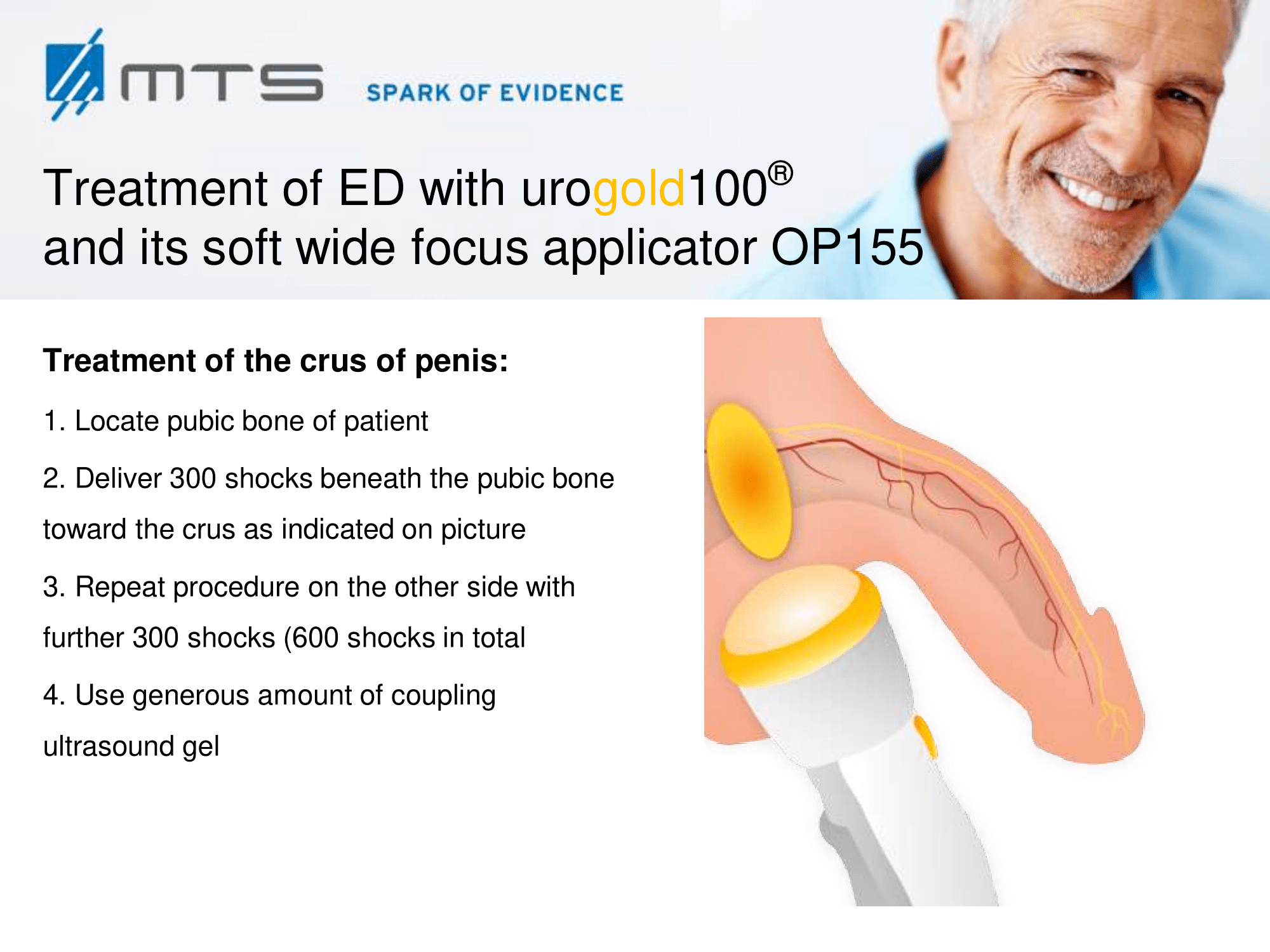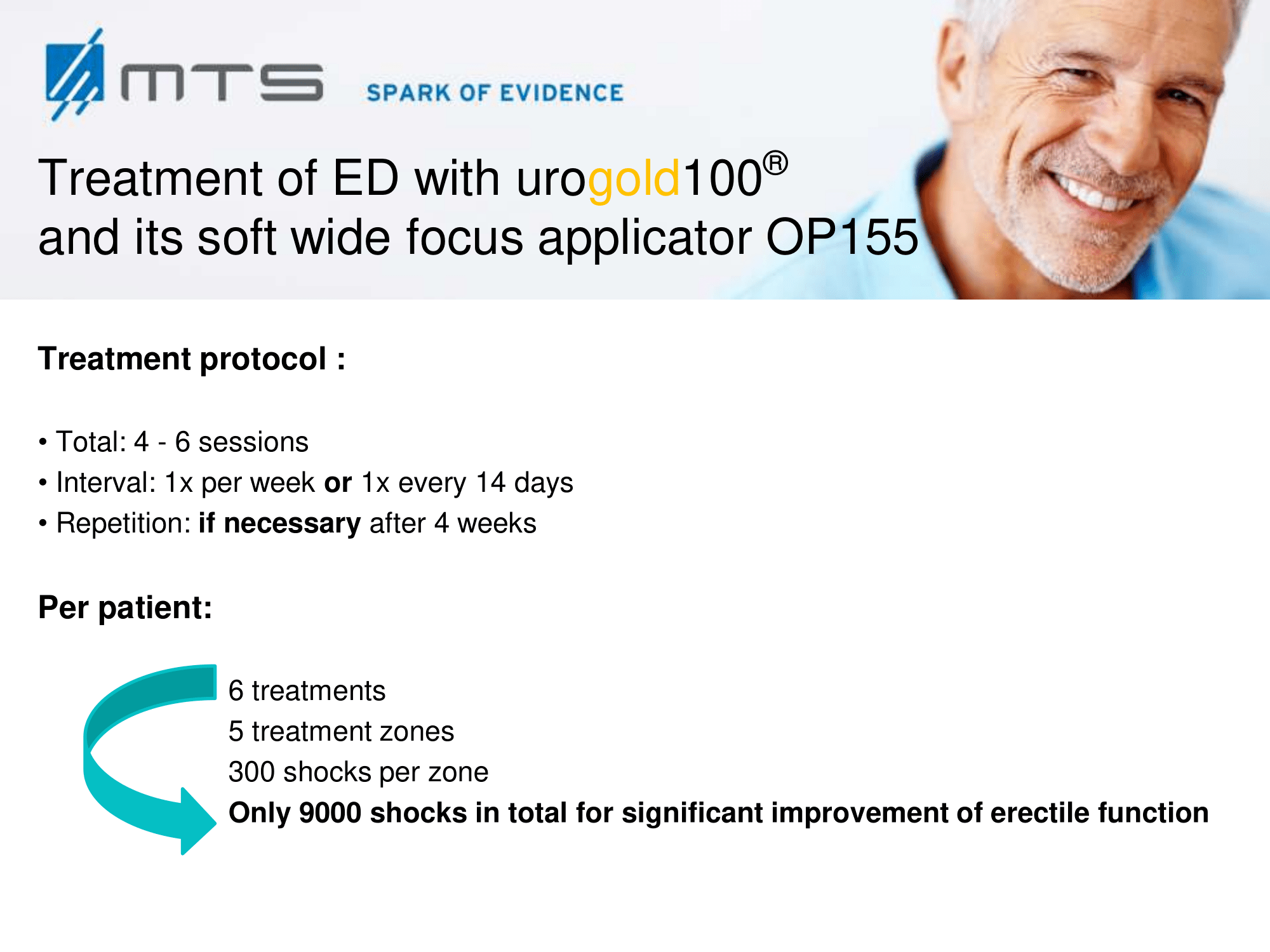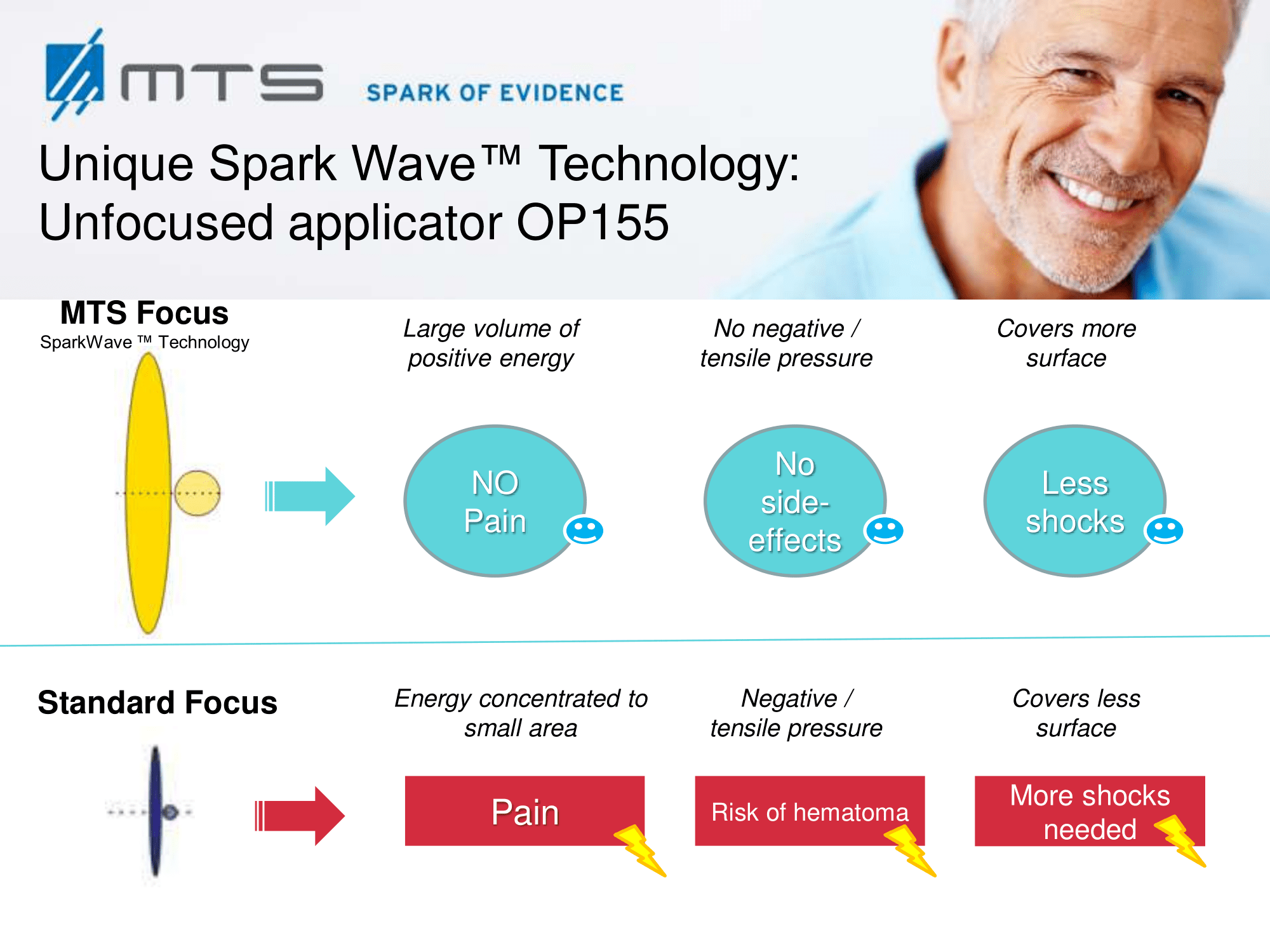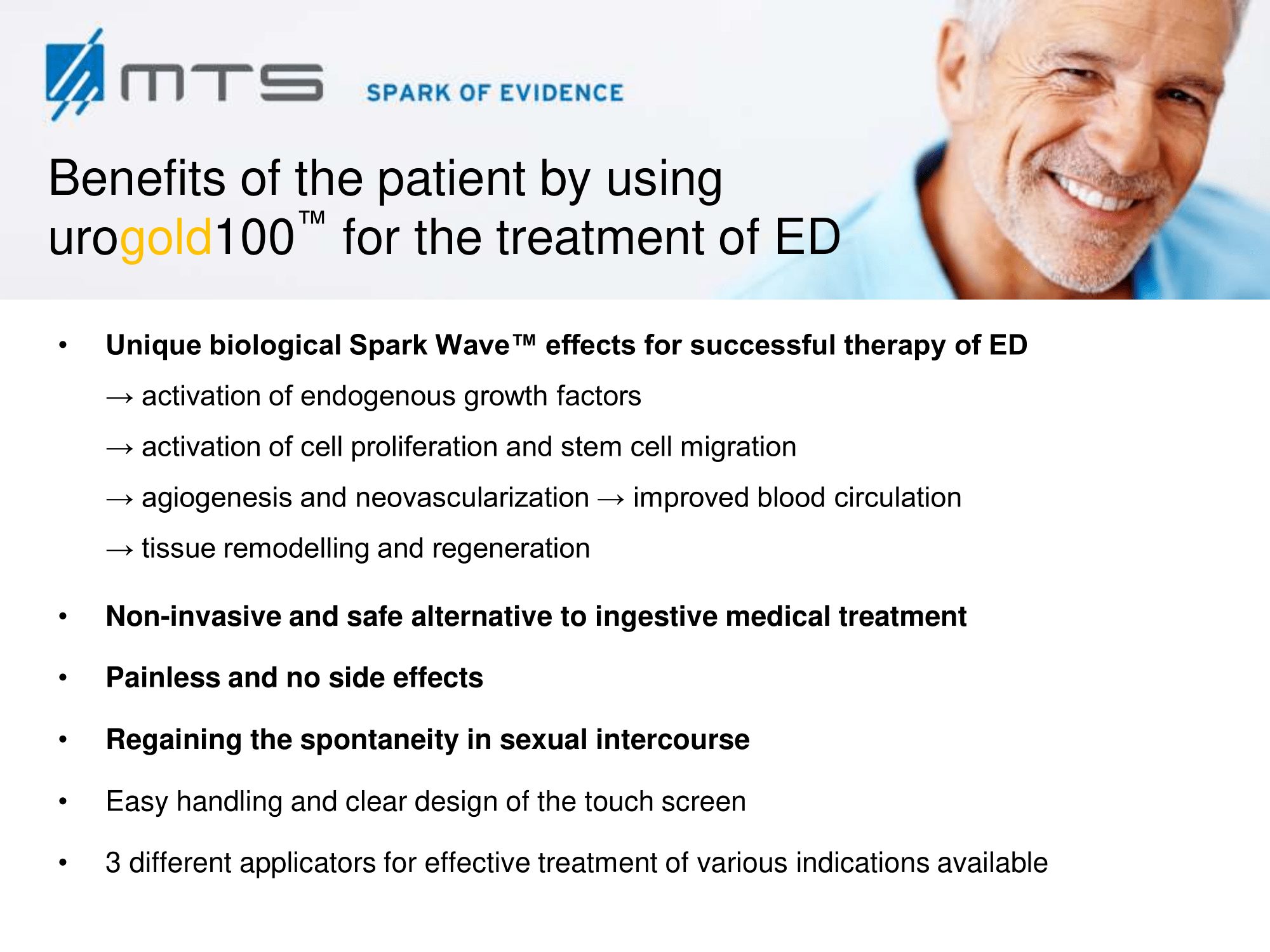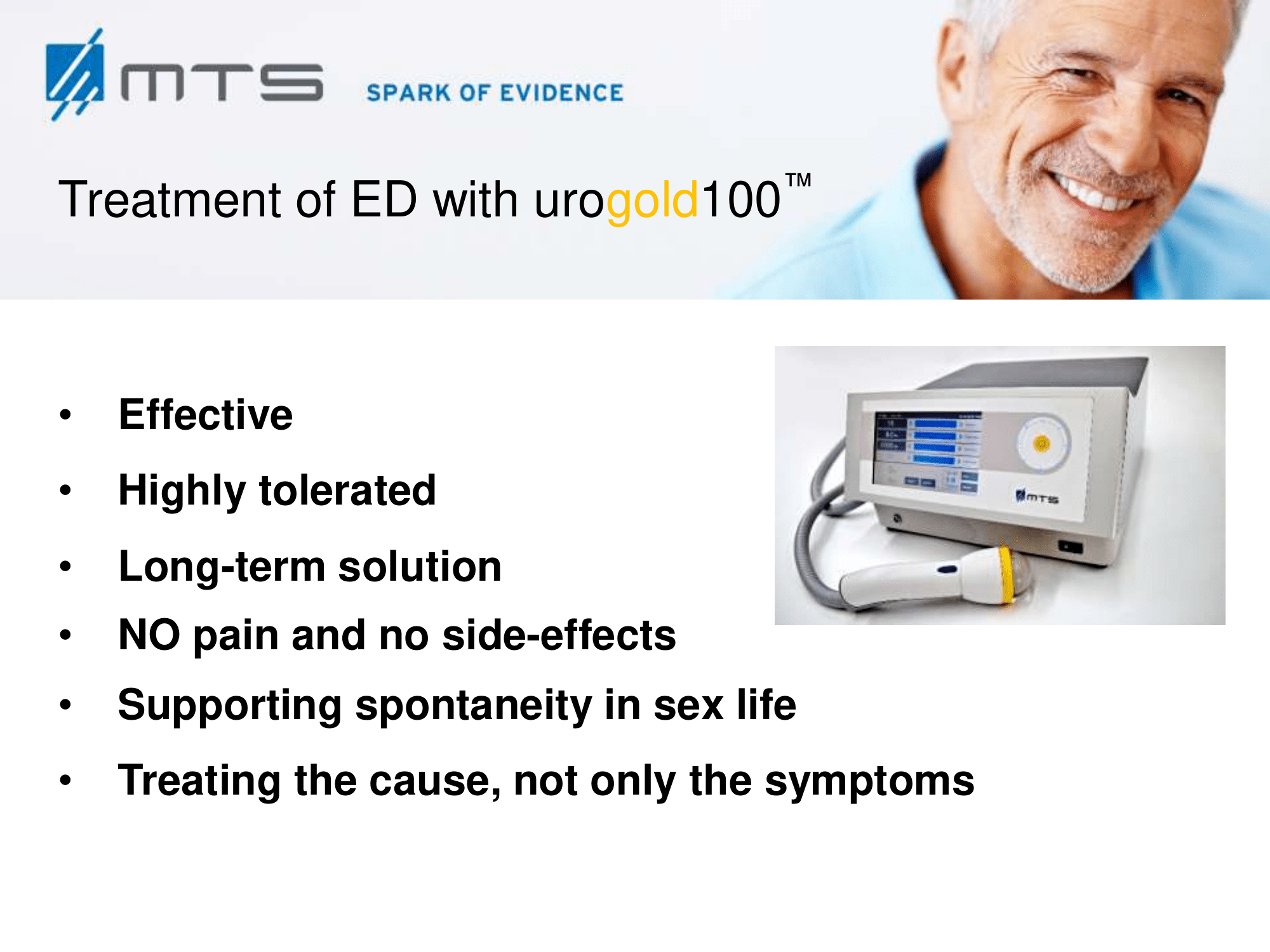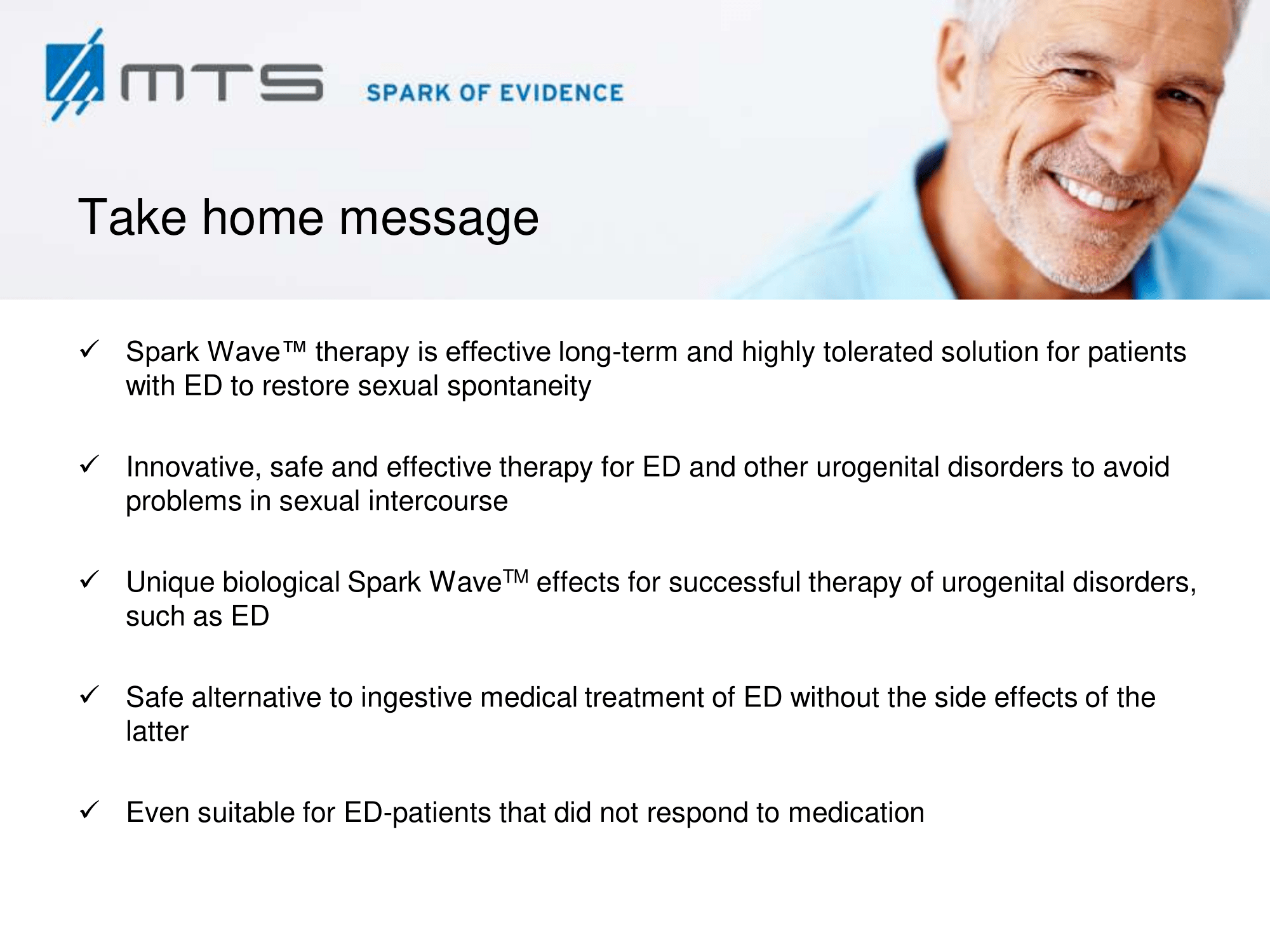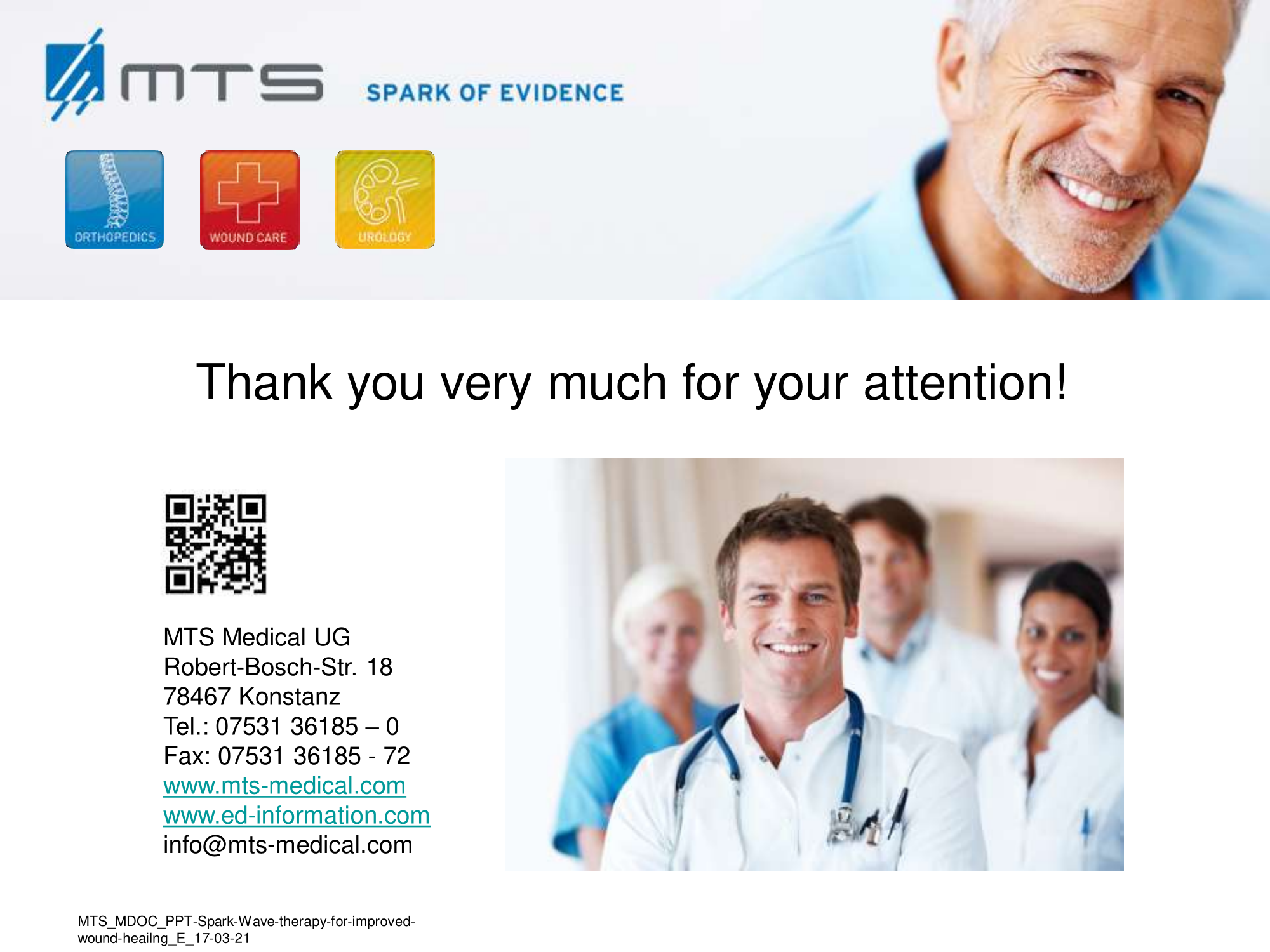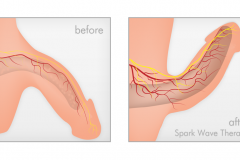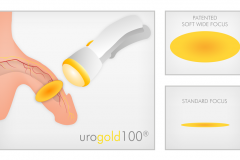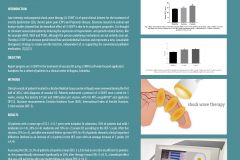Urogenital indications such as painful penile angulation, erection problems and / or chronic pain in the pelvic region frequently lead to a reduced quality of life for affected patients. Besides the actual symptoms the indications often have a negative impact on sexuality and partnership. With the new Spark Wave Therapy system urogold100 a simultaneously gentle and effective treatment option for patients with urogenital problems is now available.
Indications at a glance:
- Penile angulation (Peyronie´s disease / Induration penis plastic)
- Erectile dysfunction (ED)
- Chronic pelvic pain syndrome (CPPS).
Clinical evidence of Spark Wave® Therapy in the treatment of erectile dysfunction
Introduction / scientific background
Spark Waves emerged as an effective and specific kind of shock wave (SW) with a unique role in tissue regeneration. The medical origin of shock waves is the urological field where high-intensity SWs are applied in order to destroy kidney stones (lithotripsy). In regenerative orthopedics (orthotripsy) and wound healing where medium- or low-intensity SWs are utilized to induce tissue repair 1. The electrohydraulic shock wave machine generates acoustic waves by high voltage electrodes in an underwater explosion 2. SWs pass the skin and superficial tissues and produce physical shear forces that can be focused at a desired tissue depth causing microtrauma which in turn initiates beneficial cellular processes. It was shown that the extracorporeal shock wave therapy (ESWT) possesses anti-inflammatory properties and is able to increase the blood circulation and metabolism of the treated tissue, thus supporting the healing of bone fractures, tendon pathologies, chronic foot ulcers or ischemic heart diseases 3 4 5 6 7 8. Research about the underlying cellular mechanisms found out that ESWT causes stem cell migration and stimulates osteoblasts and fibroblasts during the recovery of bones and connective tissue 9. The SWT-induced intracellular expression of growth factors like endothelial nitric oxide synthase (eNOS), bone morphogenetic protein (BMP-2), vessel endothelial growth factor (VEGF) and proliferating cell nuclear antigen (PCNA) led to angiogenesis and revascularization in the affected areas 10 8 11. Nowadays, due to its growth-promoting effect, ESWT is used in a wide clinical approach and has become a promising treatment perspective for vasculogenic erectile dysfunction (ED), chronic pelvic pain and Peyronie`s disease 12.
Current state of research and clinical evidences in the treatment of ED by shock wave therapy
ED is one of the most common disorders of middle-aged men and is defined as the inability to achieve and maintain erections adequate for sexual intercourse 13. Although the currently available pharmacological possibilities like phosphodiesterase type 5 inhibitors (PDE5i) are more or less effective in most of the patients, the big disadvantage of this method is obvious since this simple, limited treatment of the symptoms does not correct the underlying pathophysiology and thus cannot be considered fully satisfactory. Vascular lesions secondary to diabetes mellitus, structural lesions caused by trauma or neurologic injury in consequence of prostatectomy for example are potential causes of ED 14. Due to its previously reported regeneration-promoting effects, low-intensity shock wave therapy (Li-ESWT) has been introduced to the andrological field and made great progress so far. Several studies, basic research as well as preliminary clinical trials, provided encouraging evidence for a sustainable improvement of erectile function (EF) upon Li-ESWT 15.
In 2010, Vardi et al. published the first pilot study in patients with organic ED. They demonstrated that Li-ESWT significantly increases penile rigidity and function, an observation attributed to the positive influence of ESWT on cavernosal hemodynamics 16. This issue was unraveled by Qui et al., who investigated the cellular effects of Li-ESWT on EF and tissue in a diabetic rat model 17. They reported a significant recovery of EF upon Li-ESWT due to the regeneration of nNOS-positive nerves, endothelium, and smooth muscle in the penis supported by the recruitment of endogenous mesenchymal stem cells 17. In the following years, the Vardi-team and several other groups published a series of positive outcomes from cohort studies and randomized, controlled trials (RCTs) which were recently revised in a systematic meta-analysis by Tom Lue and others 14 18. The clinical standard parameters to measure the therapeutic efficacy in ED-ESWT studies are the international index of erectile function (IIEF) and the erection hardness score (EHS). The majority of the present studies showed that men experience improvements in their EF upon Li-ESWT, regardless of variations in the set-up parameters or treatment protocols, PDE5i response or constitutional predispositions 14. The meta-analysis of Tom Lue finally suggests that SWT could significantly improve the IIEF and EHS of ED patients and corresponding research which explains the underlying mechanisms of the unique Spark Wave effect are already provided:
MTS Spark Waves® in basic research studies, effects and mechanisms
- “Effects of low-energy shock wave therapy on erectile function and tissue of diabetic rat model” 17. In this study, Spark Waves partially ameliorated diabetes mellitus-associated ED by promoting nerve regeneration of nNOS-positive nerves, endothelium and smooth muscle in the penis. Spark Waves significantly improved erectile function and intracavernous pressure (ICP). These beneficial effects appeared to be mediated by recruitment of endogenous mesenchaymal stem cells (MSCs).
- “Low-energy shock wave therapy ameliorates erectile dysfunction in a pelvic neurovascular injuries rat model” 20. Here it was shown, that Spark Waves Therapy induces endogenous progenitor cell recruitment and Schwann cell activation in the damaged area which coincides with angiogenesis, tissue and nerve regeneration and thereby improves erectile function.
Clinical evidence for MTS Spark Waves®
The majority of common studies engaging shock waves produce good results in case of mild to moderate ED levels. Recently, MTS together with the Fundació Pugivert analyzed a group of long-term patients suffering from severe ED and were initially intended for penile implantation surgery to prove that even severe cases of ED can benefit from Spark Wave Therapy in future.
| Author, publication | Title | MTS Reference center |
| 1. Curbelo et al., published at the 20th ISMST congress in San Sebastian 2017 | Penile low-intensity shock wave therapy for PDE5i non-responders suffering from vasculogenic erectile dysfunction since 2-10 years: A prospective, randomized, placebo-controlled study (2016) | Fundació Puigvert, Barcelona |
| 2.Saffón et al., published at the 23rd WAS congress in prague 2017 | Effectiveness of shock wave therapy: implementation of a soft wide focus applicator in patients with erectile dysfunction | Boston Medical Group, Colombia |
| 3. Shoskes et al., published at the 20th ISMST congress in San Sebastian 2017 | Case series of weekly low intensity shock wave (LiSW) therapy for erectile dysfunction | Cleveland clinic, Glickman Urological and Kidney Institute |
| 4.Ramon et al., published at the 20th ISMST congress in San Sebastian 2017 | Efficacy of extracorporeal shockwave therapy (ESWT) for male chronic pelvic pain syndrome: a phase III, randomized, double blind controlled with placebo study | Quiron Hospital, Barcelona |
1. “Penile low-intensity shock wave therapy for PDE5i non-responders suffering from vasculogenic erectile dysfunction since 2-10 years: A prospective, randomized, placebo-controlled study (2016)”
The Fundació Puigvert in Barcelona is one of the most renowned institutions for penile implants, specialized on urology and andrology.
Curbelo et al. investigated the effects of penile Li-ESWT on EF in long-term patients which suffered from vasculogenic ED since 2-10 years and were refractory to PDE5i. It was a randomized, simple-blind, sham-controlled study. 22 active and 19 sham treated ED patients received Li-ESWT (1 session/week for 6 weeks; 1,500 pulses of 0.10 mJ/mm2 at 5 Hz, urogold100 MTS). All patients were evaluated at baseline and 1 month after the end of treatment using validated erectile dysfunction questionnaires like the IIEF-5 and the Sexual Encounter Profile (SEP). There was no significant difference between the two groups in baseline characteristics. Baseline five-item version of the IIEF-5 mean scores, in the active and sham groups, were 10.0 ± 4 and 9.9 ± 4.6, respectively (p= 0.94). At baseline, 14% of patients in the active group (3 of 22) and 10.5% of patients in the placebo group (2 of 19) had a positive answer to the SEP 3 question “Did your erection last long enough for you to have successful intercourse?” (p= 0.8). One month after treatment IIEF-5 scores mean changes from baseline, in the active and placebo group, were 2.2 ± 4.9 and 0.25 ± 4.4, respectively (p= 0.2). SEP 3 positive responders increased to 33% in the active group (7 of 22) and even decreased in the placebo group to 5% (1 of 19) (p=0.03) after LIST. Notably, erectile function (SEP 3) could be improved significantly in a substantial proportion of active-treated patients (33%), whereas the placebo effect was zero. This prospective study, 1 month of Spark Wave treatment led to partial recovery of erectile function. Download Abstract
2. “Effectiveness of shock wave therapy: implementation of a soft wide focus applicator in patients with erectile dysfunction”
The Boston Medical Group in Colombia is treating a wide spectrum of patients suffering from ED and premature ejaculation. This network of medical offices is highly experienced in dealing with shock waves for many years now. Therefore, MTS and the Boston Medical Group investigated a mixed group of patients to analyze the positive effect of the unique Spark Wave Technology.
Saffón et al. performed a progress report on Spark Wave Therapy in the treatment of vascular ED using a SWFA (soft wide focused applicator) handpiece for a cohort of patients in the clinical center in Bogota. 20 patients with a mean age of 53.1 ±12.1 years were included and underwent a protocol of LI-ESWT once a week for 5 weeks, energy flux density 0.15mJ and 3000 pulses per session, with the MTS urogold100 and applicator OP155. The outcome was measured by the Erection Hardness Score (EHS), International Index of Erectile Function, 5-item version (IIEF-5) at the end of the therapy and at one month follow-up. At admission, 70% of patients had mild / moderate (n = 14), 20% (n = 4) moderate and 10% (n = 2) severe ED according to the IIEF-5 scale. After five sessions 25% (n = 5), and after one month follow-up even 45% (n = 9) of patients showed a clinical important difference (defined as an increase of ≥ 4 points) in the IIEF score with an average increase of 5 points (18 ±4.4, p= 0.001). Assessing the EHS, 55.5% of patients at baseline (mean EHS: 3 ±0.6) had an erection insufficient to penetrate, this proportion decreased significantly to 28% after therapy (mean EHS: 4 ±0.7, p = 0.05), a beneficial effect that was still persisting after one moth follow-up (mean EHS: 4 ±0.7, p = 0.04). The preliminary results of LI-ESWT in the treatment of ED with the MTS urogold100 and applicator OP155 are promising and indicate a clinically significant improvement in both, the IIEF and EHS by Spark Wave Technology. Download Abstract Download Poster
3. “Case series of weekly low intensity shock wave (LiSW) therapy for erectile dysfunction”
The Glickman Urological and Kidney Institute of the Cleveland clinic is recognized worldwide for excellence in patient care, teaching and research, merges the urology and nephrology programs. It offers innovative treatments in urology and nephrology, including minimally invasive, scarless options for urologic procedures and medical management of kidney disease.
In order to improve patient convenience Shoskes et al. studied the efficacy and safety of LiSW of a modified protocol of 4 weekly treatments in contrast to the standard of twice weekly treatments for 3 weeks. 8 men (PDE5i non-responders) were enrolled yielding 3000 shocks/session at 6 treatment sites (500 shocks each) with the urogold100. Energy flux was 0.13 mJ/mm2 and frequency was 4 Hz yielding a biologic energy density of 1560. ED severity was measured with the Sexual Health Inventory for Men (SHIM) score at baseline and 1 month following the 4 weekly treatments. Overall, SHIM score improved from 11.0±3.6 to 17.2±5.2 (p=0.01). SHIM was unchanged in 2 patients (25%), mildly improved in 1 patient but not sufficiently for intercourse and significantly improved with erection sufficient for intercourse in 5 patients (62.5%).
Low Intensity Shockwave Therapy with the urogold100 using a once a week protocol produced a similar success rate to previously published twice weekly protocols and improved erections sufficient for intercourse in 62.5% without side effects. Download Abstract Download Poster
4. “Efficacy of extracorporeal shockwave therapy (ESWT) for male chronic pelvic pain syndrome: a phase III, randomized, double blind controlled with placebo study”
Quiron Barcelona Hospital is one of the leading clinics involving the latest equipment and the most experienced doctors in Spain.
Silvia Ramon et al. investigated chronic pelvic pain (CPPS) which according to the National Institute of Health (NIH) is genitourinary pain or discomfort lasting 3 or more months with undetectable uropathogenic bacteria. The primary goal was to assess the efficacy of extracorporeal shock wave therapy for treatment of males CPPS. 38 patients were evaluated. ESWT group improved their pain relief statistically significantly compared to placebo group (11 +/- 3.15 vs 6.31 +/- 2.55, p <0.05). Also improved voiding quality as measured by IPSS score (11 +/- 2 vs 7.21 +/- 1.5, p <0.05) and NIH-CPSI urinary symptoms (5 +/- 1.5 vs. 3.42 +/- 1.5, p <0.05). These results were maintained until 12 week. No adverse effects were observed.
At 4 and 12 weeks, patients who received ESWT experienced improvement in pain relief, quality of life, and voiding symptoms. It has been demonstrated ESWT is an effective and safe treatment for CPPS. Download Abstract Download Poster
Future prospects of Spark Waves® in the treatment of ED
The new therapeutic concept of ED treatment by using shock waves will be the method of choice in future, since it is able to restore penile function in a gentle, non-invasive way. The key benefit is that Spark Wave leads to a long-lasting regeneration process 21 22 23. The angiogenic properties increase penile blood flow and recovery of cavernosal vasculature which will enable patients to restore spontaneous and natural erections 24 25. After numerous successful clinical trials of renowned institutions, Spark Wave Therapy becomes widely accepted and gains substantial ground in the field of ED treatment 15. The recent clinical studies performed by the Fundació Puigvert and the Boston Medical group further provide profound data about the effectiveness and safety of our urogold100 MTS device in successful treatment of penile dysfunctions. Upcoming studies of MTS with other researchers are on the way and will further contribute to a better experience and knowledge of our experts in performing Li-ESWT in the treatment of ED. We intend to further optimize the Spark Wave Therapy protocol in order to establish individualized shock wave treatment concepts to get the best results for our patients.
References
- Chung, B. & Wiley, J. P. Extracorporeal shockwave therapy: a review. Sports Med. 32, 851–65 (2002).
- Wang, C.-J. Extracorporeal shockwave therapy in musculoskeletal disorders. J. Orthop. Surg. Res. 7, 11 (2012).
- Ellah, M. A. et al. Changes of renal blood flow after ESWL: Assessment by ASL MR imaging, contrast enhanced MR imaging, and renal resistive index. Eur. J. Radiol. 76, 124–128 (2010).
- Kisch, T. et al. Repetitive shock wave therapy improves muscular microcirculation. J. Surg. Res. 201, 440–445 (2016).
- Haffner, N. et al. Extracorporeal shockwave therapy (ESWT) ameliorates healing of tibial fracture non-union unresponsive to conventional therapy. Injury 47, 1506–1513 (2016).
- Notarnicola, A. & Moretti, B. The biological effects of extracorporeal shock wave therapy (eswt) on tendon tissue. Muscles. Ligaments Tendons J. 2, 33–37 (2012).
- Wang, C.-J., Wu, C.-T., Yang, Y.-J., Liu, R.-T. & Kuo, Y.-R. Long-term outcomes of extracorporeal shockwave therapy for chronic foot ulcers. J. Surg. Res. 189, 366–72 (2014).
- Holfeld, J., Lobenwein, D., Tepek??yl??, C. & Grimm, M. Shockwave therapy of the heart. International Journal of Surgery 24, 218–222 (2015).
- Cheng, J. H. & Wang, C. J. Biological mechanism of shockwave in bone. International Journal of Surgery 24, 143–146 (2015).
- Cai, H. Y. et al. Cardiac shockwave therapy improves myocardial function in patients with refractory coronary artery disease by promoting VEGF and IL-8 secretion to mediate the proliferation of endothelial progenitor cells. Exp. Ther. Med. 10, 2410–2416 (2015).
- Xin, Z., Liu, J., Wang, L. & Li, H. Progress of low-energy shockwave therapy in clinical application. Beijing Da Xue Xue Bao. 45, 657–660 (2013).
- Fojecki, G. L., Tiessen, S. & Osther, P. J. Extracorporeal shock wave therapy (ESWT) in urology: a systematic review of outcome in Peyronie’s disease, erectile dysfunction and chronic pelvic pain. World J Urol (2016).
- Pan, M. M., Raees, A. & Kovac, J. R. Low-Intensity Extracorporeal Shock Wave as a Novel Treatment for Erectile Dysfunction. Am. J. Mens. Health 3–5 (2015). doi:10.1177/1557988315574511
- Lu, Z. et al. Low-intensity Extracorporeal Shock Wave Treatment Improves Erectile Function: A Systematic Review and Meta-analysis. Eur. Urol. 2838, 1–11 (2016).
- Gruenwald, I., Appel, B., Kitrey, N. D. & Vardi, Y. Shockwave treatment of erectile dysfunction. Ther. Adv. Urol. 5, 95–9 (2013).
- Vardi, Y., Appel, B., Jacob, G., Massarwi, O. & Gruenwald, I. Can low-intensity extracorporeal shockwave therapy improve erectile function? A 6-month follow-up pilot study in patients with organic erectile dysfunction. Eur. Urol. 58, 243–248 (2010).
- Qiu, X. et al. Effects of low-energy shockwave therapy on the erectile function and tissue of a diabetic rat modeljsm. J. Sex. Med. 6, 1–9 (2009).
- Clavijo, R. I., Kohn, T. P., Kohn, J. R. & Ramasamy, R. Effects of Low-Intensity Extracorporeal Shockwave Therapy on Erectile Dysfunction: A Systematic Review and Meta-Analysis. J. Sex. Med. 14, 27–35 (2017).
- Lin, G. et al. In Situ Activation of Penile Progenitor Cells With Low-Intensity Extracorporeal Shockwave Therapy. J. Sex. Med. 1–9 (2017). doi:10.1016/j.jsxm.2017.02.004
- Li, H. et al. Low-energy Shock Wave Therapy Ameliorates Erectile Dysfunction in a Pelvic Neurovascular Injuries Rat Model. J. Sex. Med. 13, 22–32 (2016).
- Bechara, A., Casab??, A., De Bonis, W. & Ciciclia, P. G. Twelve-Month Efficacy and Safety of Low-Intensity Shockwave Therapy for Erectile Dysfunction in Patients Who Do Not Respond to Phosphodiesterase Type 5 Inhibitors. Sex. Med. 4, e225–e232 (2016).
- Srini, V. S., Reddy, R. K., Shultz, T. & Denes, B. Low intensity extracorporeal shockwave therapy for erectile dysfunction: a study in an Indian population. Can. J. Urol. 22, 7614–22 (2015).
- Olsen, A. B., Persiani, M., Boie, S., Hanna, M. & Lund, L. Can low-intensity extracorporeal shockwave therapy improve erectile dysfunction? A prospective, randomized, double-blind, placebo-controlled study. Scand. J. Urol. 49, 329–333 (2014).
- Vardi, Y., Appel, B., Kilchevsky, A. & Gruenwald, I. Does low intensity extracorporeal shock wave therapy have a physiological effect on erectile function? Short-term results of a randomized, double-blind, sham controlled study. J. Urol. 187, 1769–1775 (2012).
- Gruenwald, I., Appel, B. & Vardi, Y. Low-Intensity Extracorporeal Shock Wave Therapy-A Novel Effective Treatment for Erectile Dysfunction in Severe ED Patients Who Respond Poorly to PDE5 Inhibitor Therapy. J. Sex. Med. 9, 259–264 (2012).
